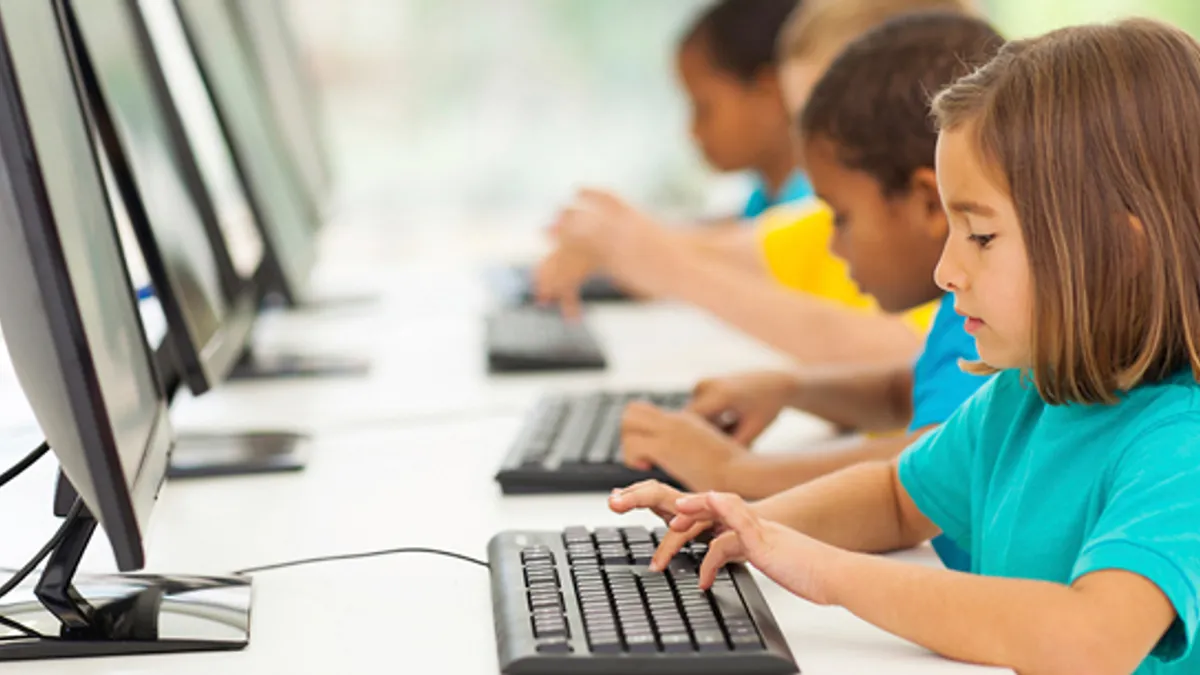Dive Brief:
- Closing the K-12 digital divide could cost $6 billion to $11 billion in the first year of such efforts as approximately 30% of all public school students lack at-home internet or adequate digital learning devices, according to a new connectivity report from Boston Consulting Group (BCG), in partnership with Common Sense and EducationSuperHighway.
- More than 50 million students have been forced to learn remotely since the onset of the COVID-19 pandemic in March, the report found. About 21% of students in urban areas are without at-home broadband, compared with 25% in suburban areas and 37% in rural areas. Native American students suffer the most from the digital divide, with 37% of those students lacking broadband. White, Latinx and Black students face an 18%, 26% and 30% digital divide, respectively.
- State and city officials must assess existing internet and device access, determine procurement and distribution options and then "find the money to pay for it all," according to the report. Jurisdictions and school districts should "build comprehensive plans based on their needs assessments that lay out the special role private or philanthropic partners can play and how students will be affected in the absence of that support," the report reads.
Dive Insight:
The digital divide plagued school systems long before COVID-19 swept the nation. A survey from nonprofit education group Speak Up found 49% of school principals saw digital equity as a "major challenge" in 2016, compared to only 30% of principals in 2010. That same survey found 17% of students could not do homework due to a lack of internet access.
Meanwhile, a March survey from the Pew Research Center found 58% of eighth-grade students in urban areas need the internet for homework almost every day.
This issue has only been exacerbated by stay-at-home orders and school shutdowns imposed to varying degrees by U.S. jurisdictions over the last eight months. The report states four key pillars to at-home learning — high-speed internet, internet-enabled learning devices, instructional content and digital literacy resources — must be funded to ensure American students don't fall behind due to pandemic restrictions. The cost breakdown of some of these resources were detailed by the report as follows:
| Resource | Cost per student |
|---|---|
| Fixed internet connection | Installation: $0-$100 Ongoing cost: $10-$50/month |
| Hot spots | Device: $60-$80 Ongoing cost: $15-$40/month |
| Supplemental service options (i.e. Wi-Fi buses) | Installation: Up to $100 Ongoing cost: $75-$80/month |
| Laptops | ~$300 |
| Chromebooks | ~$200 |
| iPads | ~429 |
Congress in March allotted $13.2 billion in federal stimulus to the Elementary and Secondary School Emergency Relief Fund and $3 billion to the Governor's Emergency Education Relief Fund to fund K-12 education and needed resources in the wake of COVID-19. Separately, 26 states have issued at least $1.5 billion of their own coronavirus relief funding to K-12 digital access, yet "these funds are still insufficient" to address the severity of the current digital divide, the report reads.
"Federal CARES Act funding helped to jump-start efforts, but it did not offer a coherent approach to closing the student digital divide and was insufficient to fully close it in any single state," a BCG spokesperson told Smart Cities Dive in an email. "[O]nly federal funding has the ability to sustainably and equitably cover costs to close the digital divide at scale – and keep it closed."
And it's not just students who suffer: the report found 10% of all public school teachers live in households without adequate internet access, and 100,000 lack proper devices. The impact of having a teacher caught in the digital divide is magnified nearly 16x on average due to the limitations on distanced learning for an entire classroom, the BCG spokesperson said — which could further leave kids behind.
"The technology divide for kids that are in homes of poverty is real," said Kyle Sipe, instructional coach for the Umatilla School District in Oregon, in an interview with Education Dive. His spouse Heidi Sipe is superintendent of the district, which reportedly purchased more than 400 hotspots for its students to take home amid the pandemic.
Other school districts and facilities have also provided students with personal hotspot devices or outfitted infrastructure with such Wi-Fi capabilities. San Francisco announced it would install 25 Wi-Fi "SuperSpots" across its city to support at-home learning, while Hopewell City Public Schools in Virginia made efforts to retrofit 31 of its school buses with wireless internet routers and deploy those buses in densely populated neighborhoods.
The BCG report also highlighted broader work in a number of counties and cities, including Chattanooga, TN, that have deployed citywide municipal internet initiatives to address the digital divide beyond its impacts on schools. Students are not the only individuals struggling to complete work tasks remotely, and some cities may choose to address the issue more holistically through projects to bolster connectivity for all residents.
These efforts will not be easy, however, as governments grapple with strained municipal budgets. An assessment of need will be a critical step in governments' and school districts' procurement of connectivity services, particularly in negotiating contracts that can front-load costs to take advantage of federal relief funding, the report reads.












